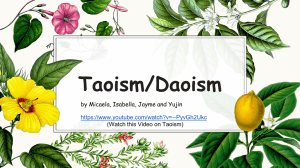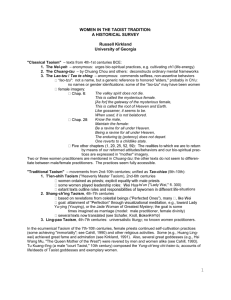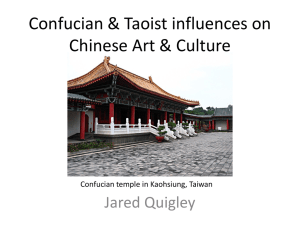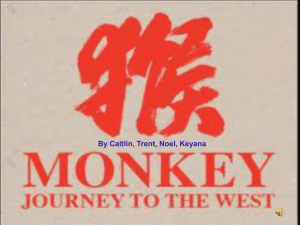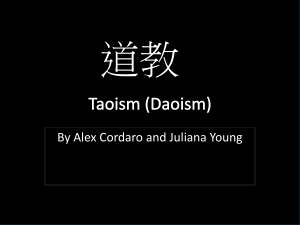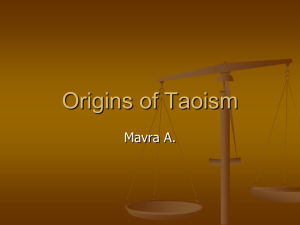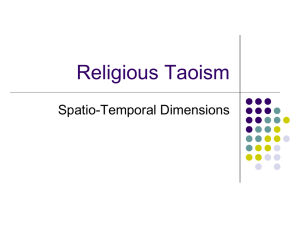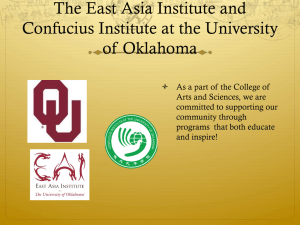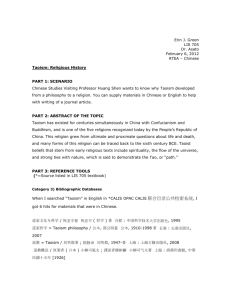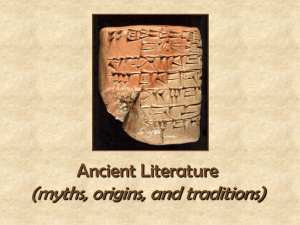The Founder of Taoism
advertisement
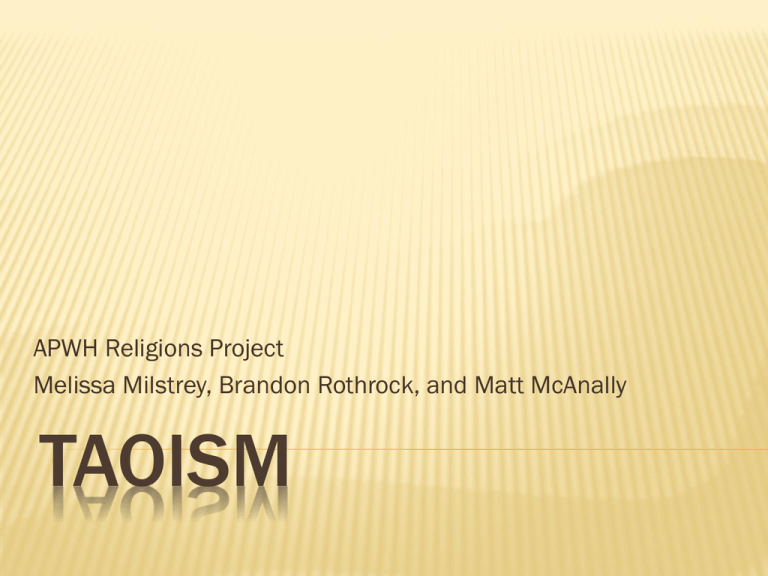
APWH Religions Project Melissa Milstrey, Brandon Rothrock, and Matt McAnally TAOISM “When there is this abstinence from action, good order is universal.” FOUNDER(S) Many give credit to Laozi, born around 614 B.C.E (older than even Confucius) His writings began the Taoist movement. Historians dispute over the exact time of founding, others disputes refer to the existence of Laozi at all. Laozi is the author of Tao-te ching, which Taoism bases its philosophy off of. Laozi literally means “Old Master” HISTORICAL CONTEXT OF FOUNDING The foundational text of Taoism is “Daode Jing”, meaning Scripture of the Way and its Virtue. This was written by Laozi, the assumed founder of the philosophy. It was written to confront the reader with Daoism's essential point, which is: “The Dao that can be trodden is not the enduring and unchanging Dao. The name that can be named is not the enduring and unchanging name” SYMBOL(S) OF TAOISM Taoism had many different symbols, both derived from everyday items surrounding them and also other new formed symbols that originated based on their ideals. •The Yin-Yang is the infamous symbol of the Taoists that represents the main ideals of their philosophy involving balance of weakness (yin) and strength (yang). • Mountains are another important symbol of the Taoists, depicted in their art forms, that represents the land of the immortals and retreat from the negative. • Another sacred symbol of the Taoists was the tortoise which represented immorality in their philosophy. •The Yang, strength, is not only represented by the Yin-Yang symbol but also a dragon. DEITIES’ NAMES Along with the philosophy of Taoism came a list of deities worshiped in their tempes. In these temples different ceremonies for each of their deities were conducted. Yu-huang is considered the Jade Emperor, meaning he is the highest God of the Taoists. All other gods must report to him, and his function was to serve justice. San-ch’ing is translated into The Three Ones. They are Yu-ch’ing, known as Jade Pure, Shang-ch’ing, known as Upper Pure, and T’ai-ch’ing, known as Great Pure. They were not rulers, but they sought to save mankind by teaching and benevolence. Though Yu-huang is the High God, other dieties, such as Yuan-shih T'ientsun, are above him. He is considered the first principle, and he is selfexisting, invisible, limitless, is present in all places, and is the source of all truths. LOCATION OF ORIGIN Taoism originated in Classical China, providing explanation as to why all of central writings are in Chinese. It is an Eastern religious philosophy. Classical China MAJOR LOCATIONS TODAY Taoism has spread from it roots in China all across the globe. While it is still popular today in China, it is more popular in modern day Taiwan. It is also popular today in the United States of America. With the stress of everyday life at an all time high Americans like the simplicity and harmony of the religion. Many “Taoist Hermits” are spread throughout the country, and practice the philosophies of Taoism by themselves in seclusion from the rest of civilization. NUMBER OF FOLLOWERS While it is difficult to get an exact number of followers modern day, reliable data bases point towards approximately 20 million modern day followers spread throughout the globe. Of the approximately 20 million followers, about 30,000 of them are believed to life in the US, predominantly in the western half of the country. NUMBER OF FOLLOWERS HOW AND WHY THE PHILOSOPHY SPREAD Taoism spread successfully and swiftly from its roots in ancient China. Taoism was a religion appreciated by the upper class and high level society, leading it to gain the respect of imperial governments and spread rather quickly. HOLY BOOKS AND IMPORTANT TEXTS Tao te Ching- “Morality Scripture” a collection of stories and poems written by Lao Tze. The book explains the way of the Tao, and how to properly live. Chuan Tzu- written by Chuang Tzu or Zhang zi (same person) is a collection of primary Taoist doctrines. It includes the Wu-wei which talks about how to be in harmony with the Tao. Lie Zi- written by Lie Yukou who was believed to be a hundred schools of thought philosopher. ROLES OF MEN AND WOMEN Men had a much higher role in society than woman during the time period, and this was held true in the teachings of the Taoists. However, Taoists did see women higher than normal because they create life, and there is an emphasis on harmony with the earth, which is seen in the natural qualities of females. However, women were not allowed to make social decisions and were expected to run the household. PLACES OF WORSHIP The Taoists worshiped in the Gong, or temple, where they would perform their various ceremonies Diverse in size relative to location and demography of attending people Shows a new twist on traditional Chinese architecture like the Dragon and Tiger that are in the front of the temple and are wooden framed, typically built along mountains Used Taoist symbols to decorate wood work of the hall of the temples HOLY SITES AND WHY Map Key (1) is the home of Lau Tsu (2) where Tao Te Ching had a realization about Taoism (4) Mao shan, a Taoist pilgrimage site. (6) Ch’ ingchen Shan in Chengdu, another Taoist pilgrimage site where temples and a monastery are located. HOLIDAYS The main holidays of the Taoists are: Chinese New Year (beginning of New Year – different than lunar calendar) Lantern Festival (First Full moon of Tomb Sweeping Day (day of Ghost Festival (like the Chinese Dragon Boat Festival (poet’s day) Mid-Autumn Festival (family the year) ceremonies at the tomb of ancestors) Halloween) members celebrate, Spring Festival) MAJOR BELIEFS Creation Story The story of the Chinese philosophical creation talks about the Myth of Pan Ku: Creation and the Universal Egg. In the beginning of time, there was chaos, and the shape of the chaos was an egg. For 18,000 years the egg was incubating until it hatched, and when it hatched, the heavens and the earth came into existence. At the same, the giant Pan Ku was born. His size divided heaven and earth, and with the assistance of four creatures, a tortoise, a dragon, a phoenix, and a unicorn, he created the earth that’s seen today. When Pan Ku perished, he became “one with nature” meaning his body transformed into the environment. MAJOR BELIEFS End Times Story The Taoists did not actually believe in the end of time, they did agree with the fact of death as a natural part of life (did not have significance on their way of living) They did not believe in an afterlife, but instead that death was the “ultimate end”. MAJOR BELIEFS IMPORTANT COMMANDS AND LAWS 1) Law of the Yin Yang-there must always be a balance of yin and yang, existing in every part of life 2) Law of Mutual Immanence-yin yang is mutually immiscible 3) Law of Dynamics -existence itself is dynamic The Taoists basically wanted all of their people to focus more on internal balance with nature instead of the world and technology around them. Anyone that did not follow the laws of the universe and life depicted above were not only denying all that is right but also causing personal disorder. This relates to how Taoists believe that advancements in empires will actually bring their downfall and also the fact that simplicity is best. MAJOR BELIEFS Purpose of Life Taoists believed that if human nature was aligned perfectly with the rest of nature, the result would be both harmony and order. When people deviate from the natural order, they are only bringing destruction upon themselves. The only way to encourage natural behavior is by using a model leader. A model emperor once said, “He who governs his body, governs the country” (Patheos.com). Basically you exist to become one with nature. INFLUENCE ON ARCHITECTURE Taoist architecture included various buildings in which religious ceremonies were held, such as temples, palaces, nunneries, and altars. It was very similar to Buddhist architecture, as it could be divided into holy halls used for sacrifice or houses to live in. Most of the temples are wooden framed, and surrounded by man-made gardens. The philosophy pursues the unity of humans and nature, and Taoist architecture greatly reflects that. ARCHITECTURE INFLUENCE ON ART Taoist art was ornate and was influenced mainly by immortals. The immortals the closest any person could be to nature, so average followers wanted to become one with nature. An example of this art can be seen with the Fanghu Isle of Immortals, which was on the previous slide. Because it is assumed that Laozi was the founder of Daoism, most of the art created emphasize him. The artists were mostly Taoist masters, adepts, or scholars. The lotus was also a common Taoist symbol, because it was associated with humans’ true nature, and it was believed humans grew out of mud. ART Immortal Laozi Daoist Immortals Vase with Immortal THANKS FOR WATCHING SOURCES "Taoism." BBC News. BBC, 2012. Web. 17 Oct. 2012. <http://www.bbc.co.uk/religion/religions/taoism/>. "Taoism Symbols." Way of Perfect Emptiness. N.p., 2012. Web. 17 Oct. 2012. <http://www.taopage.org/taoism_symbols.html>. “The Taoist Deities." The Taoist Deities. N.p., 2011. Web. 17 Oct. 2012. <http://www.chebucto.ns.ca/Philosophy/Taichi/gods.ht ml>. Lynn. "The Founder of Taoism." The Founder of Taoism. The Way of Perfect Emptiness, 2012. Web. 17 Oct. 2012. <http://www.taopage.org/taoism_founder.html>. "Taoist Architecture." China Culture. N.p., 2007. Web. 17 Oct. 2012. <http://arts.culturalchina.com/en/83Arts4940.html>. SOURCES Augustin, Birgitta. "Heilbrunn Timeline of Art History." Daoism and Daoist Art. New York Universtiy, 2000. Web. 17 Oct. 2012. <http://www.metmuseum.org/toah/hd/daoi/hd_daoi.htm>. Hardy, Julia. "Taosism Beliefs." Patheos Library, 2008. Web. 17 Oct. 2012. <http://www.patheos.com/Library/Taoism/Beliefs/HumanNature-and-the-Purpose-of-Existence.html>. "Daoism." Discovering Mandarin. N.p., 2009. Web. 17 Oct. 2012. <http://discoveringmandarin.blogspot.com/>. Binizir, Ali. "Tao of Dating." N.p., 2012. Web. 17 Oct. 2012. <http://www.google.com/imgres?imgurl=http://taoofdating.c om/images/covers/TaoOfDatingForMen_AliBinazir_s.jpg>. SOURCES Kardash, Ted. "Taoist Sanctuary." Ageless Wisdom for a Modern World. Taoist Sanctuary of San Diego, 2012. Web. 17 Oct. 2012. <http://www.taoistsanctuary.org/taoism/moderntao.html>. "Religion Map Caption." Sacrd Sites of Taoism. N.p., 2011. Web. 17 Oct. 2012. <http://www.wadsworth.com/religion_d/special_features/popu ps/maps/schmidt_patterns/content/map_28.html>. "Religion: Taoism." BBC News. BBC, 2012. Web. 17 Oct. 2012. <http://www.bbc.co.uk/religion/religions/taoism/>. "Chinese Taoist Temples." TravelChinaGuide.com. N.p., 2012. Web. 17 Oct. 2012. <http://www.travelchinaguide.com/intro/architecture/styles/chi nese-taoist-temples.htm>.
